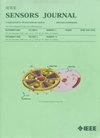基于结构性 Ti3C2Tx MXene 的三波段太赫兹超材料吸收器,用于增强传感应用
IF 4.3
2区 综合性期刊
Q1 ENGINEERING, ELECTRICAL & ELECTRONIC
引用次数: 0
摘要
高性能太赫兹(THz)窄带超材料吸收器(MMA)在传感应用中占据着重要地位。然而,目前大多数用于折射率(RI)传感的 MMA 通常只能在单波段或双波段范围内表现良好,或者表现出相对较低的传感性能。本研究提出了一种基于三圆柱壳(TCS)结构 Ti3C2Tx MXene 的三波段 MMA,并对其进行了数值研究,以增强太赫兹区域的 RI 传感应用。我们的方法的基本思想在于利用 Ti3C2Tx MXene 独特的电磁(EM)特性来实现多波段吸收和增强传感能力。我们使用有限元法(FEM)和等效电路法(ECM)对所设计的 MMA 进行了全面的数值模拟分析。仿真结果表明,所提出的 MMA 在 1.20、1.55 和 1.91 太赫兹波段分别实现了 99.97%、94.54% 和 99.65% 的高吸收率。这种强吸收归因于波导模式与表面等离子体极化子(SPPs)之间的混合耦合效应,模拟电磁场和能量分布也证明了这一点。值得注意的是,我们的 MMA 的三波段吸收特性可以通过调整其单元格的几何参数轻松调整。此外,MMA 还具有卓越的传感性能,灵敏度分别高达 1.79、1.40 和 1.13 THz/RIU。简单的设计、强大的吸收能力和更高的灵敏度使我们的 MMA 结构有望应用于太赫兹生物传感、材料检测和通信系统。本文章由计算机程序翻译,如有差异,请以英文原文为准。
Tri-Band Terahertz Metamaterial Absorber Based on Structural Ti₃C₂Tₓ MXene for Enhanced Sensing Application
High-performance terahertz (THz) narrow-band metamaterial absorbers (MMAs) occupy a central position in sensing application. However, the majority of current MMAs for refractive index (RI) sensing typically only perform well within a single or dual-band range, or exhibit relatively low sensing performance. In this work, a tri-band MMA based on tri-cylindrical-shell (TCS) structure Ti3C2Tx MXene is proposed and investigated numerically for the enhanced RI sensing applications in THz region. The fundamental idea behind our approach lies in harnessing the unique electromagnetic (EM) properties of Ti3C2Tx MXene to achieve multiband absorption and enhanced sensing capabilities. A comprehensive numerical simulation analysis of the designed MMA was conducted using the finite element method (FEM) and the equivalent circuit method (ECM). The simulation results demonstrate that the proposed MMA achieves remarkably high absorbance levels of 99.97%, 94.54%, and 99.65% at 1.20, 1.55, and 1.91 THz, respectively. This strong absorption is attributed to the hybrid coupling effect between waveguide modes and surface plasmon polaritons (SPPs), as evidenced by the simulated EM fields and energy distributions. Notably, the tri-band absorption characteristics of our MMA can be easily tuned by adjusting the geometric parameters of its unit-cell. Moreover, the MMA exhibits exceptional sensing performance, with sensitivities of up to 1.79, 1.40, and 1.13 THz/RIU, respectively. This combination of straightforward design, robust absorption capabilities, and heightened sensitivity makes our MMA structure a promising candidate for applications in THz biosensing, material detection, and communication systems.
求助全文
通过发布文献求助,成功后即可免费获取论文全文。
去求助
来源期刊

IEEE Sensors Journal
工程技术-工程:电子与电气
CiteScore
7.70
自引率
14.00%
发文量
2058
审稿时长
5.2 months
期刊介绍:
The fields of interest of the IEEE Sensors Journal are the theory, design , fabrication, manufacturing and applications of devices for sensing and transducing physical, chemical and biological phenomena, with emphasis on the electronics and physics aspect of sensors and integrated sensors-actuators. IEEE Sensors Journal deals with the following:
-Sensor Phenomenology, Modelling, and Evaluation
-Sensor Materials, Processing, and Fabrication
-Chemical and Gas Sensors
-Microfluidics and Biosensors
-Optical Sensors
-Physical Sensors: Temperature, Mechanical, Magnetic, and others
-Acoustic and Ultrasonic Sensors
-Sensor Packaging
-Sensor Networks
-Sensor Applications
-Sensor Systems: Signals, Processing, and Interfaces
-Actuators and Sensor Power Systems
-Sensor Signal Processing for high precision and stability (amplification, filtering, linearization, modulation/demodulation) and under harsh conditions (EMC, radiation, humidity, temperature); energy consumption/harvesting
-Sensor Data Processing (soft computing with sensor data, e.g., pattern recognition, machine learning, evolutionary computation; sensor data fusion, processing of wave e.g., electromagnetic and acoustic; and non-wave, e.g., chemical, gravity, particle, thermal, radiative and non-radiative sensor data, detection, estimation and classification based on sensor data)
-Sensors in Industrial Practice
 求助内容:
求助内容: 应助结果提醒方式:
应助结果提醒方式:


